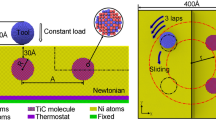Abstract
The aim of this article was to provide a systematic method to perform molecular dynamics simulation or evaluation for nano-scale interfacial friction behavior between two kinds of materials in MEMS design. Friction is an important factor affecting the performance and reliability of MEMS. The model of the nano-scale interfacial friction behavior between two kinds of materials was presented based on the Newton's equations of motion. The Morse potential function was selected for the model. The improved Verlet algorithm was employed to resolve the model, the atom trajectories and the law of the interfacial friction behavior. Comparisons with experimental data in other paper confirm the validity of the model. Using the model it is possible to simulate or evaluate the importance of different factors for designing of the nano-scale interfacial friction behavior between two kinds of materials in MEMS.
Similar content being viewed by others

References
Granick S. Soft Matter in a Tight Spot[J].Physics Today, 1999, 52(7): 26–31
D M Tanner. Reliability of Surface Micromachined MEMS Actuators[C].Proceedings of the 22nd International Conference in Microelectronics, NIS, Yugoslavia, May 2000: 97–104
Gang He and Mark O Robbins. Simulations of the Static Friction Due to Adsorbed Molecules[J].Phys. Rev. B, 2001, 64, 035413.
DONG Hai-jun, WANG San-min, LI Jian-hua, CHEN Guo-ding. Ultra-Solid-Lubrication and Its Application Prospect in MEMS[J].Mechanical Science and Technology, 2002, 21 (2): 266–268
Yasushisa Ando, Jiro Ino. Friction and Pull-off Force on Silicon Surface Modified by FIB[J].Sensors and Actuators, 1996, 57(2): 83–89
Li Yufeng and A Kmenon. The Development and Implementation of Discrete Texture for the Improvement of Tribological Performance[J].Trans. ASME. J. Tribology, 1995, 117 (1): 279–284
Chandrasekaran, Nagasubramaniyan. Molecular Dynamics Simulations of Machining, Materials Testing, and Tribology at the Atomic Scale[J].Dissertation Abstracts International, 2001, 62-08(B): 3763–3770; Adviser: Ranga Komanduri
T Iwasaki. Molecular Dynamics Study of Adhesion Strength and Diffusion at Interfaces between Interconnect Materials and Underlay Materials[J].Computational Mechanics, 2000, 25 (1): 78–86
Gang He and Mark O Robbins. Simulations of the Kinetic Friction due to Adsorbed Surface Layers[J].Tribology Letters, 2001, 10(1): 7–14
Komanduri R, Chandrasekaran N, Raff L M. MD Simulation of Nano-metric Cutting of Single Crystal Aluminum effect of Crystal Orientation and Direction of Cutting[J].Wear, 2000, 242(1): 60–88
Wang H, Hu Y Z, ZOU Kun, Leng Y S. Molecular Dynamics Simulations of Nano-tribology[J].Science in China (Series A), 2001, 31(3): 261–266
Din Jianning, Meng Yonggang, Wen Shizhu. Scale Dependence of Tensile Strength of Micromachined Polysilicon MEMS Structures due to Microstructural and Dimensional Constrains [J].Chinese Science Bulletin, 2001, 46(3): 1392–1396
Author information
Authors and Affiliations
Corresponding author
Additional information
Funded by Natural Science Foundation of Guangxi Province of China (No. 0339037), the Support Program for Young and Middleaged Disciplinary Leaders in Guangxi Higher Education Institution, the Science Foundation for Qualified Personnel of Jiangsu University (04JDG027), and the Innovative Science Foundation of Jiangsu University.
Rights and permissions
About this article
Cite this article
Ping, Y., Linbo, L., Jianning, D. et al. Nano-scale interfacial friction behavior between two kinds of materials in MEMS based on molecular dynamics simulations. J. Wuhan Univ. Technol.-Mat. Sci. Edit. 21, 173–176 (2006). https://doi.org/10.1007/BF02841232
Received:
Accepted:
Issue Date:
DOI: https://doi.org/10.1007/BF02841232



